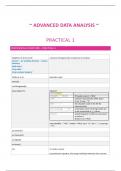Samenvatting
samenvatting: practicum 1 + 2 (take-home assignment) - 10/10
Deze samenvatting omvat practicum 1 en 2 (take home-assignment). De samenvatting heeft de opdrachten met oplossingen en bijhorende codes alsook samenvatting van de ppt over de practica. Ik heb 10/10 gehaal door gebruik te maken van deze samenvatting tijdens het tussentijdse open-boek examen.
[Meer zien]



